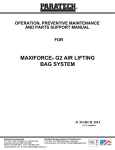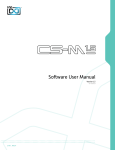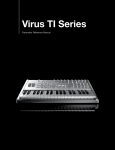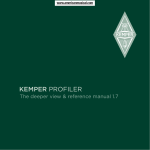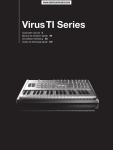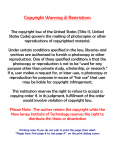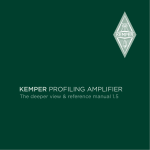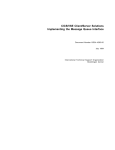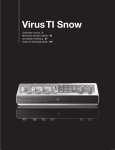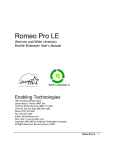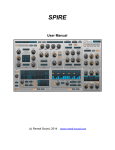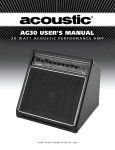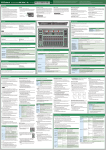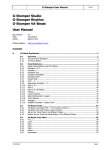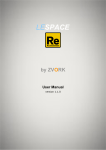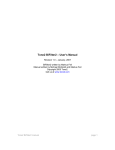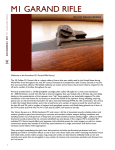Download Addendum - Access Music
Transcript
Addendum Software version 4.5.1 TABLE OF CONTENTS Table Of Contents 9 What’s new in version 4.5.1? New storrage location for your own patches 11 What’s new in version 4.5? Vintage Chorus Hyper Chorus Air Chorus Rotary Speaker Additional Modulation Sources 17 What’s new in version 4.0? Arp To Matrix Enhanced Arpeggiator Editor in Virus Control Vintage Distortions Distortion Types Speaker Cabinet Vowel Filter Comb Filter 25 What’s new in version 3.3? New Distortion and Shapers Frequency Shifter and Ring Modulator Ring Modulator Frequency Shifter Characters Tape Delay Side Chain Audio Troubleshooting Sync Error 35 What’s new in version 2.7 About Atomizer Support for multiple devices SOFTWARE 6 ADDENDUM New output preference About Virus Control Center Control Center’s Advanced Menu 26 ROM Banks Part Priority 39 What’s new in version 2.5? Live Mode Button Additional Soft Knob Destinations 41 What’s new in version 2.0? Complex Grain Table Oscillator Simple Formant Table Oscillator Complex Formant Table Oscillator Wavetable PWM Oscillator Enhanced Wavetable Synthesis Section Locking Inactive Parameters Patch Complexity Indicator Search By Category Two new ROM banks 52 What was new in previous versions? Mac Intel support Direct monitoring VU style level meters Remote Mode 112 Additional Multi Patches Search by Name Display of Original Value Adaptive Soft Limiter Algorithm 55 Tutorials and glossary Where to find tutorial sessions? Glossary TABLE OF CONTENTS Legal Notice © Copyright 2008-2010 Kemper Digital GmbH. All rights reserved. This manual, as well as the software and hardware described in it, is furnished under license and may be used or copied only in accordance with the terms of such license. The content of this manual is furnished for informational use only, is subject to change without notice and should not construed as a commitment by Kemper Digital GmbH. Kemper Digital GmbH assumes no responsibility or liability for any errors or inaccuracies that may appear in this book. Except as permitted by such license, no part of this publication may be reproduced, stored in a retrieval system, or transmitted in any form or by any means, electronic, mechanical, recording, by smoke signals or otherwise without the prior written permission of Kemper Digital GmbH. Virus is a trademark of Kemper Digital GmbH. All other trademarks contained herein are the property of their respective owners. All features and specifications subject to change without notice. www.access-music.de [email protected] SOFTWARE 8 ADDENDUM WHAT’S NEW IN VERSION 4.5.1? What’s new in version 4.5.1? New storrage location for your own patches OS 4.5.1 does not include new features but there is one important change we would like to bring to the attention of MacOS users. The location where YOUR OWN patches are being stored in has changed to the following location: ~/Documents/Access Music/Virus TI/Patches/ The installer automatically moves all you patches to the new location. 10 SOFTWARE ADDENDUM WHAT’S NEW IN VERSION 4.5? What’s new in version 4.5? OS 4.5 for the entire Virus TI series of synthesizers brings you additional effects such as new choruses and a rotary speaker as well as addition mod matrix sources. A selection of new patches illustrates the new sonic capabilities. Those can be found using Virus Control’s patch browser, simply look for “OS45 New Features patches”. Vintage Chorus TIOS 4.5 brings several new types of chorus effect to the Virus TI series, ranging from faithful models of renowned vintage chorus and tremolo effects, to the brand new Hyper Chorus. The Vintage Chorus is an emulation of the 70’s chorus technology based on a technique known as “bucket brigades”, which can be considered a predecessor of today’s digital sampling technology. The Vintage Chorus covers not only the exact sound of the famous Chorus Ensemble but also many other derivatives of that era which were based on the same basic circuitry, most notably that of the built-in chorus of the Juno 60. You may notice the somewhat dull sound of the effect signal; this is due to the limited sample-rate of the bucket brigade. When this signal is mixed to the direct sound, it will result in a very warm chorus sound, because the overall signal gets a low and mid frequency boost. The Vintage Chorus is always in full stereo as you have one chorus each for the left and right sides, modulating in opposite ways. •• Rate Use the Rate parameter to adjust the speed of the chorus modulation. •• Depth Use the Depth parameter to adjust the intensity of the chorus modulation Tip: For the original Chorus Ensemble sound leave the Depth parameter at middle position and dial your sound by the Rate parameter - the original did not have a depth control. For the original “Juno 60” Chorus sound leave Depth at 100% and dial your sound by adjusting Rate. The “Juno 60” Chorus did not have a Rate or Depth control, just two buttons labeled ‘I’ and ‘II’ to switch between two rates - the equivalent settings in the Vintage Chorus can be achieved by setting Rate Control at 25% (I) and 45% (II). •• Mix Use the Mix parameter to adjust the balance between the dry input signal and the output of the chorus effect. For the maximum chorus effect, Mix should be set to 127. 12 SOFTWARE ADDENDUM Note: When using the Classic chorus, Mix should be still be set to the middle position (64) for maximum effect. •• X-Over Each of the new chorus types in OS 4.2 features a X-Over (crossover) parameter. By turning up the value of X-Over you can shield the lower frequencies from the influence of the chorus modulation, thus giving the sound a stable bottom-end. This feature was inspired by specialised bass chorus units; we found, however, that this type of crossover control is not merely an advantage for bass sounds - it is suitable for shaping any sound. Note: If you happen to own an original chorus unit from the analog era, you may notice that our choruses don’t feature a volume boost when you switch them on. This is because of our philosophy to always try to have equal volumes on our effects, compared to the unprocessed signal. This makes it easier for you to find the best effect based purely on its character, and not to favour one effect over another simply because of its volume boost. Hyper Chorus The Hyper Chorus is probably one of the most advanced choruses ever made; it is a six- voice chorus with up to three delay lines each for the left and right side. Despite this, it is staggeringly simple to use, as it is usually only necessary to adjust only the Depth parameter to achieve a huge, warm sound. •• Depth By adjusting Depth you change the amount of detune and fatness that the chorus adds to the signal - everything else is perfectly adjusted to give you the lushest chorus sound with no further tweaking necessary. You can even choose very small detunes without the typical comb filter effect of a regular chorus, and when you bring Depth to zero the chorus effect completely goes away, even with the Mix parameter left at full position. •• Amount As the full sound could be too complex, you have the option to draw delay lines in and out of the chorus. With the Amount parameter you can continuously control the numbers of delay lines from one to three per side. So yes, even 1.5 choruses are possible: this simply means one chorus is at full volume, the other is at half - you can think of the Amount parameter as being roughly equivalent to the Oscillator Amount parameter for the HyperSaw oscillators of the Virus. •• Mix Use the Mix parameter to adjust the balance between the dry input signal and the output of the chorus effect. For the maximum chorus effect, Mix should be set to 127. Note: When using the Classic chorus, Mix should be still be set to the middle position (64) for maximum effect. WHAT’S NEW IN VERSION 4.5? •• X-Over Increase the value of the X-Over parameter to shield the lower frequencies of the input signal from the effect of the chorus. Air Chorus The Air Chorus is a subtle kind of chorus, as it doesn’t mix the direct sound to the processed signal; instead, it modulates the pitch of the left and right side of the signal independently from each other. The resulting chorus sound happens in the air between both speakers, where both signals add together - hence the name. •• Depth As with the Hyper Chorus, the Depth Control will usually be the only control you need for achieving the sound you want. At higher values you get a noticeable but delicate chorus, whilst lower values will create a subtle stereo widening of the soundstage but without the typical beating of a chorus. •• X-Over The X-over Parameter enables you to position the bass and middle frequencies of your signal to a stable mono position between your speakers, while the highs will still float around. •• Vibrato The Vibrato effect modulates the pitch of the sound by a sine modulation. •• Rate Use the Rate parameter to adjust the speed of the modulation. •• Depth Use the Depth parameter to adjust the intensity of the modulation. •• X-Over Use the X-Over parameter to blend out the vibrato effect for the lower frequencies of the signal. This will guide you to an old-school modulation effect, quite similar to a scanner vibrato of a Hammond organ. 14 SOFTWARE ADDENDUM Rotary Speaker The Rotary Speaker chorus type is an extremely faithful recreation of the sound made by the legendary Leslie speaker - best known for the wonderful effect it has on the sound of the Hammond organ. The Leslie speaker modulates the sound by rotating both the bass speaker drum and the tweeter horn inside a cabinet - but, crucially, they are rotated at different speeds from each other. The result is a complex example of the Doppler effect, and the way it affects the sound is magical - it’s basically like a vibrato, tremolo and chorus in one. The Leslie speaker also works surprisingly well with both electric and acoustic pianos - the result is a very distinctive sound, instantly recognisable from many iconic recordings. Tip: Although the Rotary Speaker effect includes a speaker cabinet, try using the “Speaker Cabinet” in the Characters section of the Virus at the same time for an even more distinctive sound. •• Speed Use the Rate parameter to switch between Slow and Fast rotation. You will notice that the change in rotation speed is not immediate - the main reason for this is that the bass rotor takes considerably longer to change its speed than the tweeter horns. Tip: If you would prefer to have continuous control over the Rate parameter, or to set values in between the Slow and Fast rates, you can still target Chorus Rate in the mod matrix. •• Mic Angle Use the Angle parameter to adjust the angle of the microphone relative to the speakers. Full stereo width is achieved at 180° and -180°. If you want the effect to be mono, set Angle to 0° (middle position). •• Low/High Balance Use the High/Low Balance parameter to adjust the balance between the outputs of the bass rotor and the tweeter horn. Lower values result in a darker and duller sound, and higher values will result in a brighter, thinner sound. For a faithful emulation of the classic Leslie sound, leave the parameter set to the middle position. •• Distance Use the Distance parameter to adjust the distance of the microphones from the cabinet from 4 cm to 30 cm. The closer the microphones, the more intense the amplitude modulation (tremolo) will be. •• Mix Use the Mix parameter to adjust the balance between the input signal and the output of the Rotary Speaker effect. For authentic organ patches, this is best left at 127, but other values can be very useful if you want to try using the rotary effect with less conventional sounds, such as synth pads. WHAT’S NEW IN VERSION 4.5? Additional Modulation Sources TIOS 4.5 allows brand new sound-shaping possibilities, thanks to the addition of 9 new modulation sources in the Mod Matrix: •• Unipolar LFOs The three LFOs in the Virus TI are all bipolar by default. This means that when you target a parameter with any of them, its value is modulated both positively and negatively away from the original value. A bipolar LFO looks similar to the following diagram: In TIOS 4.5 each of the 3 LFOs can now be selected in unipolar mode. This means that the modulation only occurs in one direction away from the current value of the target parameter. *In the list of modulation sources, you will see each LFO listed as both bipolar and unipolar. You are free to select either version of a particular LFO for any modulation slot within the same patch, as the LFO itself is not affected by the selection. •• Analog Key Many of us have owned a vintage analog synth at some time or another, and most of those that have will be only too aware of their tendency to become increasingly unpredictable in their behaviour. Unstable tuning and inconsistent key-tracking are just two typical symptoms of this. The funny thing is, these characterful instabilities can be just as inspiring as they are infuriating - it is often these little quirks that help a sound stand out in the mix. 16 SOFTWARE ADDENDUM In TIOS 4.5, we have provided a way to introduce some of these quirks into the Virus, by way of the Analog Key modulation sources. The idea is to deliberately skew the key tracking in such a way as to create inconsistency across the keyboard, but in a repeatable way. So, by this method, you can make it so that certain keys are always off pitch by a certain amount, or are duller or brighter than the keys on either side, for instance. There are two variations of these offsets, allowing you offset different parameters by a different arrangement across the keyboard. Each version is available as either Fine or Coarse. •• AnaKey 1/2 Fine Use these modulation sources to offset parameters that affect pitch on certain keys. This might include the cutoff of a filter with very high resonance. Note: when applied to other parameters, the effect of Analog Key 1/2 Fine will likely be so subtle that you won’t notice any difference. In this case, please try one of the Coarse versions instead. •• AnaKey 1/2 Coarse Use these modulation sources to offset the value of any parameter in the Mod Matrix on certain keys. In most cases, you will find these unsuitable for modulating pitch, as the effect is extreme, even when modulation Amount = 1. •• Constant Offsets The internal resolution of the parameters in the Virus sound engine is 24-bit, which theoretically allows for approximately 16 million different values for each continuously variable parameter. The MIDI specification, however, only allows for a resolution of 128 values per parameter. Now, in most situations, a resolution of 128 values is plenty, as it still allows you to get “close enough for government work”. There are occasions, however, when you might find you really want to tune a parameter so precisely that the value you need is somewhere in between two of these 128 positions. This is why we have introduced the ability to apply a constant offset to any continuous parameter via the Mod Matrix. •• 1% Constant Use this to fine tune any continuous parameter by up to 1% of the available range. This will likely only be noticeable when modulating parameters that affect pitch, including the cutoff frequency of a filter with very high resonance. •• 10% Constant Use this to fine tune any parameter by up to 10% of the available range. In situations when Offset 1% is too subtle, try this instead. Tip: By targeting another mod slot with a constant offset, you can achieve much higher precision in the Mod Matrix than is otherwise possible. WHAT’S NEW IN VERSION 4.0? What’s new in version 4.0? With TIOS4, the next operating system for the entire Virus TI series of synthesizers, your chances to need additional effects are becoming slim. Six meticulously modeled overdrive stomp boxes greatly complement with the existing arsenal of distortion algorithms in the effect section. The new speaker cabinet emulation is a fantastic and easy-to-use toolkit to add further character; especially to roaring acid lead and sync sounds. You like retro style? Our new Vowel filter will be your best friend, offering a sonic pallet from Talk Box to WahWah sounds. The Comb filter puts the metallic shine on your patches known from many glitch and progressive tracks. And The new arpeggiator allows you to modulate any of the parameters available to the modulation matrix. If you haven’t already, install the software upgrade while reading and dial up the over 60 new example patches, illustrating the new features of OS4. The new patches can be found by opening the “OS4 New Features patches.mid” file in Virus Control. 18 SOFTWARE ADDENDUM Arp To Matrix OS4 for the Virus TI series introduces a powerful new feature that allows you use the arpeggiator pattern to modulate any of the parameters available to the modulation matrix. You can use this to create dynamic, rhythmical patterns within a sound, similar to what you can achieve with a step sequencer. For this purpose, we now have an additional Arpeggiator Mode, called “Arp To Matrix”. To use this feature, you must select “Arp Input” as the Modulation Source, and ensure that the Arpeggiator is switched ON. The velocity amount of each arpeggiator step is then applied as a modulation value. •• Arp Mode = Up/Down...Chord In these traditional modes, the arpeggiator will still behave as normal, triggering a note at each active step. If “Arp Input” is selected in the Mod Matrix, the velocity values of each step will also modulate any of the available destination parameters. •• Arp Mode = Arp To Matrix When you select the “Arp To Matrix” mode the arpeggiator will no longer trigger any notes, but so long as you select “Arp Input” as a modulation source, the velocity values of each step can be used to modulate any of the available destination parameters. Please be aware that the “Note Length” parameter has no effect in “Arp To Matrix” mode. The “Swing” parameter can still be applied as usual. Tip: To hear the desired effect, be sure to either create your own User pattern in Virus Control, or any of the presets from Pattern 3 upwards - neither the default User pattern nor Pattern 2 contain any variation between the velocities of each step, so the resulting effect will be a constant offset. Enhanced Arpeggiator Editor in Virus Control Creating your own User pattern in the Arpeggiator is now more intuitive and fun than ever, thanks to some new controls on the ARP editor page in Virus Control. •• Randomise Step Use this to randomize the On/Off status of each step within the pattern length boundary. •• Randomise Velocity Use this to randomize the velocity values of each step within the pattern length boundary. WHAT’S NEW IN VERSION 4.0? •• Randomise Note Length Use this to randomize the length of each step within the pattern length boundary. •• Pattern Shift buttons Very often, especially when creating new patterns with the randomizer, you may find that the groove you have created is exactly what you want, except for one thing: it falls on the wrong beat of the bar. For this purpose, we have included two arrow buttons which you can use to shift the pattern in either direction, one step at a time, until it is in the correct phase. Click on either arrow to shunt all the steps that fall within the pattern boundary one step to the right or left. The steps at either end of the pattern will wrap around accordingly. •• Fill Up Pattern Right-click anywhere in the pattern window to bring up a context menu - from here, selecting “Fill Up Pattern” performs a repeat-copy of the currently active steps to the rest of the pattern. This is particularly useful for performing minor edits to an otherwise repetitive pattern. •• Reset Pattern Right-click anywhere in the pattern window to bring up a context menu - from here, selecting “Reset Pattern” will reset all those steps which fall within the pattern length boundary to how they were originally saved in the patch you are editing. Vintage Distortions OS4 brings 6 more distortion flavors to the table, modeled on vintage guitar distortion pedals. Every one of these classic pedals is famous for its distinctive character and has been exploited by some of the greatest guitar heroes of all time. Having carefully modeled the distortion curves and tonal characteristics of these legendary effects, including tone controls where appropriate, we have then optimized the gain stage to ensure the best possible results when using them with synthesizer and keyboard sounds. •• Drive Use this to boost the gain of the signal as it comes into the distortion stage - the higher the gain, the more distorted the sound. •• Tone Some of the original distortion pedals that inspired this collection are equipped with tone controls. See each 20 SOFTWARE ADDENDUM •• Mix Use this to balance the dry, original signal with the output of the distortion effect. Tip: To allow for greater flexibility, we have retained the Mix and High Cut parameters for alI of the Vintage Distortions. If you wish to recreate the authentic tone of the original pedal, Mix should be left at 100% and High Cut at 0%. •• High Cut Use this to soften the sound of the distortion by attenuating the higher frequencies. The higher the value of High Cut, the more attenuation is applied*. WHAT’S NEW IN VERSION 4.0? Distortion Types Type Sounds like ... Tone Control Mint Overdrive The sound of this one just screams ‘tubes’ - a very special kind of overdrive which results in a wonderful ‘smokey’ tone. Good for achieving a subtle distortion effect whilst still retaining headroom for dynamics. Use the Tone control to soften the sound with a lowpass filter. Curry Overdrive A more extreme distortion Like in the original, this does not feature a Tone control. Saffron Overdrive The ‘orange’ one. A very harsh distortion, popular with the grunge movement. The bipolar Tone control allows for great versatility by combining both a low pass and a high pass filter turn it down for a warm, dark tone, and up for a harsh, brittle sound. Onion Overdrive A big distortion effect famous for its fuzzy character. This effect uses a dual filter array, similar to the Saffron Overdrive. Use lower values to soften the sound with a low pass filter, and higher values for a brighter, thinner sound. Pepper Overdrive A clear, powerful distortion that’s perfect for making leads cut right through the mix. Use the Tone control to soften sound with a lowpass filter. Use the Tone control to soften the sound with a lowpass filter. Chili Overdrive A classic “fuzzbox” overdrive. No tone control, just in-your-face fuzz. Speaker Cabinet To complement the new vintage distortion models, we have also created a new Character Type, designed to recreate the frequency response of a speaker cabinet. This is a very useful and versatile effect, as not only does it sound fantastic with any sounds that use the distortion effects, but it is also a simple and intuitive way to fine-tune the frequency response of any sound to help give it more focus in a mix. To use, please select Character Type = “Speaker Cabinet” 22 SOFTWARE ADDENDUM •• Intensity Use this to adjust the weighting of the frequency spectrum. Lower values will push the spectral balance towards the lower frequencies, resulting in a more boomy sound, and higher values will push it towards the upper frequencies, for a brighter, thinner tone. •• Frequency Use this to tune the mid Frequency Peak. Tip: If you are using the Speaker Cabinet in conjunction with Distortion, try using the High Cut parameter in the Distortion effect to apply some high-end roll-off to the overall sound. Vowel Filter This effect is a simple and effective way to make any patch sound as though it is being vocalized, i.e. through a vocoder or talk box. To use, please select Frequency Shifter Type = “Vowel Filter” •• Vowel Use this control to sweep through the vowel table: “u..o..â..a..ä..e..i..iü..ü..ö..oe..o..u”. To modulate this parameter, select “FreqShifter Freq” as the destination in the mod matrix. •• Resonance Adjust Resonance to reduce or intensify the peaks of the vowel filter. •• Stereo Phase Use this to offset the position vowel table between the left and right channels, thereby creating a wide stereo image. •• Mix Use this to adjust the balance between the dry signal and the output of the Vowel Filter Comb Filter A versatile effect, useful for creating anything from subtle, pitched overtones to extreme time-warped destruction. To use, please select Frequency Shifter Type = “Comb Filter” WHAT’S NEW IN VERSION 4.0? •• Frequency Use this to determine the pitch at which the comb filter will resonate. Values are shown in MIDI note numbers from C0 to C8. To modulate this parameter, select “FreqShifter Freq” as the destination in the mod matrix. •• Resonance Adjust resonance to reduce or intensify the resonant effect of the comb filter. •• Stereo Phase Use this to offset the frequency of the comb filter between the left and right channels, thereby creating a wide stereo image. •• Mix Use this to adjust the balance between the dry signal and the output of the Comb Filter 24 SOFTWARE ADDENDUM WHAT’S NEW IN VERSION 3.3? What’s new in version 3.3? Operating system version 3 is a landmark in Access’ history of free OS updates. Multiple new effects have been added including a Tape Delay simulation, a Frequency Shifter algorithm and several new and exciting distortion and sound shaper algorithms. Characters allow you to alter the overall sound of a preset in reminiscence of well known synthesizers of the past. All new effects were designed to allow everything from subtle of change through to altering the sound beyond all recognition. The algorithms were created with both sonic quality and a low CPU footprint in mind. A tremendous amount of research went into the new additions ensuring a totally different level of quality in comparison to the legacy algorithms. But even the legacy algorithms have been improved by additional parameters which makes them more flexible and powerful. We also worked hard on making Virus Control and Total Integration even better. Audio now can be streamed from the DAW into your the Virus TI. Virus Control’s visual appearance was revamped and will be much easier on your eyes. The new OS 3.3 is a maintainance release to OS 3.0 recommended to all users. Sub releases attributed as a Public Beta version should be used with caution in productive environments. OS 3.3 also adds compatibility with Mac OS X 10.6 (32-bit and 64-bit), Windows XP (32-bit and 64-bit), Windows Vista (32-bit and 64-bit) as well as Windows 7 (32-bit and 64-bit). For further details, please check the Change Log and Read Me files which can be found in the documentation directory. 26 SOFTWARE ADDENDUM New Distortion and Shapers The Distortion effect has received a significant upgrade. Along with a new distortion algorithm and several new shaper curves, we have added two significant enhancements in the form of the virtual Treble Booster circuit and High Cut filter. All of the new distortion types benefit from an immense gain range of 80 dB. To ensure 100% backwards compatibility with existing Virus presets, we have retained all the original distortion types, each of which can also make use of the Treble Booster and High Cut parameters. •• Type The new available types are: Type Wide Distortion This starts with a distortion shape softer than that of a tube, but you can make it scream like mad when you turn Intensity all the way up. Soft Bounce A new shaper type, where the signal is softly bounced from the headroom ceiling at which point it distorts. Hard Bounce Similar to Soft Bounce, but this time the bounce has edges, thereby reaching a harsher distortion at a lower Intensity level. Sine Fold As the signal reaches +0dB it is folded in the shape of a sine wave. As Intensity is increased, more and more zero-crossings are created, resulting in harsh distortion. Triangle Fold Similar to Sine Fold, but a bit harsher. Diagram WHAT’S NEW IN VERSION 3.3? Type Diagram Sawtooth Fold The most brutal shaper of all. At the zero crossings the signal falls straight from the maximum positive level to the negative level, creating extremely hard distortion. Bit Reducer Reduces the word-length of each sample as you increase Intensity to create a classic lo-fi effect. Whereas the effect of the Rate Reducer is to destroy the frequency content of the sound, the Bit Reducer can have a devastating effect on the quality of low-amplitude signals. Unlike the vast majority of bit-reduction effects, in the Virus the level of reduction is continuously variable. Rate Reducer Reduces the sampling rate as you increase Intensity. This introduces aliasing and a digital stepping of the waveform, resulting in an extreme lo-fi effect Please be aware that you will not be able to hear a new selection made from the Type list until you play a new key. •• Intensity Use Intensity to determine the amount of gain applied to the incoming signal. For all the new distortion types, when distortion Intensity = 0, then no distortion occurs, and as you increase Intensity the sound will begin to distort at a certain point (the louder the input signal, the sooner this point will occur). In each case the distortion shape is volume-compensated to ensure the sound never gets too loud as you increase the gain. In many cases, you will hear the greatest contrast between the different types when Intensity is set to a value less than maximum, so be sure to tweak Intensity each time you change the type. •• Treble Booster The Treble Booster is a special kind of filter that pushes the spectral balance of the signal towards the midrange and high frequencies. This in combination with a distortion will produce richer harmonic content and result in a more lively distortion effect. Guitarists have been using Treble Booster circuits to achieve this effect on Guitar amps for decades, but even without distortion the Treble Booster can be a nice tool to emphasise certain aspects of the sound. When Treble Booster = 0 (default) it will have no effect on the sound. •• High Cut The High Cut is a steep filter, that allows you to take the harshness from the distorted sound, if desired (the speaker of a guitar amp plays a similar role). You can use High Cut to make the distortion sound more gentle or - in a certain sense - more analog. As with the Treble Booster, it will also effect the clean sound. When High Cut = 0 (default) it will have no effect on the sound. 28 SOFTWARE ADDENDUM Frequency Shifter and Ring Modulator In addition to the Input Ring Modulator the Virus TI gains two new effects: the Ring Modulator and the Frequency Shifter, both of which are great for creating wild, atonal modulations to the output of the synth engine. Depending on your model of TI, there are different ways to access the Ring Modulator/Frequency Shifter: Model Access Virus TI2 Press EFFECTS SELECT (Lower Row) until the OTHERS LED is brightly illuminated. If necessary, locate the Frequency Shifter page of the EDIT FX menu by using the PARAMETERS buttons. Virus TI Press EFFECTS EDIT (Lower Row) twice. If necessary, locate the Frequency Shifter page of the EDIT FX menu by using the PARAMETERS < > buttons. Virus TI Snow EDIT/SHIFT+EFFECTS, then locate the Frequency Shifter page of the EDIT EFFECTS menu by using the PARAMETERS < > buttons. It is listed after the Phaser pages. Ring Modulator The Ring Modulator effect takes the output of the synth engine and multiplies it with a sine wave - the result you hear is a combination of the ‘sum’ and ‘difference’ frequencies of the two signals. •• Mix Use the Mix parameter to determine the depth of modulation, from 0ff (0) to 127 (full ring modulation). It is also possible to achieve an amplitude modulation (AM) effect, by setting Mix to a value of 64. •• Frequency Use the Frequency parameter to determine the pitch of the sine wave. This is a bipolar parameter, whereby centre position (+0) will result in no audible ring modulation. As you increase or decrease the value past +0, you will hear the rate of modulation increase dramatically, introducing high-pitched overtones to the sound. •• Phase Use the Stereo Phase parameter to offset the phase of the sine wave for the left and right channels, thereby widening the stereo image. WHAT’S NEW IN VERSION 3.3? Frequency Shifter The Frequency Shifter is a rarely seen effect, which can be thought of as a kind of ‘deluxe’ version of the Ring Modulator. It is as useful for creating beautiful tremolo-like effects as it is for making high-pitched, clangorous noise. Like the Ring Modulator, it uses a sine wave to modulate the output of the synth engine, but in such a way as to produce only the ‘sum’ or ‘difference’ frequencies of the two signals. In contrast to a Pitch Shifter, which preserves the dependencies of the harmonics, the Frequency Shifter bends these dependencies, resulting in a bell-like spectrum. You can sometimes get a similar effect from a shortwave radio which has not been tuned correctly. •• Frequency Use the Frequency parameter to determine the pitch of the sine wave. This is a bipolar parameter, whereby centre position (+0) will result in no audible frequency shifting. Increase or decrease the value past +0 to hear the rate of modulation increase dramatically, introducing high-pitched overtones to the sound. Tip: To achieve a nice, stereo tremolo effect, use values only slightly above or below +0. With Mix set to 64 and Phase set to either 0 or 127. This effect can be further enhanced by setting Shape L and Shape R to opposite extremes. •• Phase Use the Stereo Phase parameter to offset the phase of the sine wave for the left and right channels, thereby widening the stereo image. •• Shape L/ Shape R Use the Left/Right Shape parameters to mix the sum and difference frequencies. At the maximum value of +63 (default) you will only hear the sum frequencies on the respective channel, and at the minimum value of -64 you will only hear the difference frequencies. If you set both channels to +0, the effect will be analogous to the Ring Modulator, so if at any time you find this is the effect you prefer, then it is advisable to switch to the dedicated Ring Modulator, which takes less calculation power. Characters Use the Characters section to apply subtle changes to sound of the filters, the oscillators, and the character of the nonlinearities and distortions throughout the instrument. Years of research and experience has enabled us to equip the Virus TI with a variety of characters inspired by legendary analogue devices, as well as some custom characters designed to enhance the sound in various ways. The ‘Analog Boost’ effect from earlier Virus models is now presented as a Character type, under the name ‘Classic’. To select and edit the Character, press EFFECTS SELECT in the lower FX row until the CHARACTERS LED is brightly illuminated. In the first Virus TI (2004-2008) models, this LED is labelled ‘ANALOG BOOST’. 30 SOFTWARE ADDENDUM In the Virus TI Snow, the Character parameters are located in the Effects edit menu. To enter this menu press EDIT/SHIFT+EFFECTS. •• Type Use Type to select the Character. •• Intensity Use Intensity to adjust the depth of the Character. This parameter is only available to certain Character types. •• Tune Use Tune to focus the effect of the enhancement on the desired point in the frequency spectrum. This parameter is only available to certain Character types. Tape Delay The Tape Delay effect is inspired by the kind of analog tape delay machines that have been in use from the early 1950’s to the present day. The use of a tape loop array to continuously record, playback and overdub an audio signal adds a very distinctive character to the sound, most notably in the saturation that occurs along with the roll-off of the high and low frequencies with each pass of the loop. For the Virus TI, we have created a unique effect which offers all the character of a traditional tape delay, whilst streamlining the controls to be more fun and more performance-friendly than ever before.To select and edit the Tape Delay press EFFECTS SELECT in the upper FX Row button until the DELAY LED is brightly illuminated. In the Virus TI Snow, press EDIT/SHIFT+EFFECTS, then use the PARAMETERS < > buttons to locate the relevant page. •• Type Select the type of delay. Mode Algorithm Classic The delay effect from Viruses past. Tape Clocked Clock-synced tape delay effect with no pitch-shifting artefacts. Tape Free Tape delay effect with freely adjustable delay time but no pitch-shifting artefacts. WHAT’S NEW IN VERSION 3.3? Mode Algorithm Tape Doppler Tape delay effect with freely adjustable delay time, complete with pitch-shifting artefacts as you adjust the delay time. •• Send Values between Off and 96 determines how much of the dry signal is sent to the delay. As you increase the value beyond 96, you are determining the balance between the dry signal and the delay output, until at Send = 127 the dry signal is faded out altogether. •• Delay Time Adjust the length of time between each repeat from 0.0 ms to 693.6 ms. •• Clock L/R (Ratio) Use these parameters to set the clock division of each stereo channel. For multi-tap effects, set them to different values, with the Left channel set as the higher amount. As with the Classic Delay, if the chosen clock division exceeds the maximum delay time at the current tempo, the value will be halved automatically. For the Tape Delay modes which are not clocked, there is instead a Ratio parameter which is displayed as a pair of numbers (1/4...4/1). The first number in each pair represents the left channel, and the second number the right channel. •• Feedback Feedback determines how much of the delayed signal is fed back into the delay to be repeated again - in other words, it determines how many echoes you will hear after each new transient, and this is one of the areas where we have designed a unique system to ensure useful, musical results every time. When Feedback=0% there will only be one audible repeat. As you increase the feedback, the number of repeats increases until, at Feedback = 100% (centre position), the delayed signal will continue repeating indefinitely. As you push the values above 100%, the delayed signal will be driven into saturation, but the overall volume will never increase, meaning you maintain full control over the levels at all times. If you wish to kill the Feedback instantaneously, you can use the Panic function (MONO+SYNC). •• Frequency As mentioned already, one of the characteristics of a tape delay is the low and high frequency roll-off with each pass or repeat, often with a controller for both frequency bands. In the Virus TI, the Tape Delay employs an elegant solution to this by using a special kind of bandpass filter. Use the Frequency parameter to choose which frequencies are fed into the delay signal. Lower values will let only the lower frequencies through, whilst higher frequencies will allow only the high frequencies through. 32 SOFTWARE ADDENDUM •• Bandwidth Use Bandwidth to control the width of the bandpass filter. At Bandwidth = 0, all frequencies are allowed through, and as you increase the value, the bandwidth becomes increasingly narrow, with feedback levels maintained at all times. •• Modulation Use Modulation to simulate the inaccuracy and instability of the tape medium by modulating the delay time. When Depth = 0 there will be no modulation. Side Chain Audio Streaming audio from the sequencer into the Virus TI was one of the top five feature request since the Virus TI was released. Version 3.0 enables a stereo side chain input in Virus Control which can be fed from virtually every other audio or instrument track in the same project. In order to use the side chain inputs you need to configure Virus Control first. Click on the PATCH/UTILITY tab in Virus Control and then select CONFIG. Now change the USB AUDIO MODE to “3 Outputs / 1 Input”. Next, select an Input preset in Virus Control by opening the browser tab and typing “Input” in the search field. The last step is to select an audio track as a source for your side chain input. In Apple Logic for instance, you can select the source track at the right upper corner of Virus Control window. You cannot use the Virus as a sound card and enable side chaining at the same time. Words of caution: Depending on the host sequencer you’re using, you may find there are one or two hurdles to jump before side chaining will work. For details on how to use side chaining in your favourite DAW, please refer to the DAW’s user manual. Also note that the side chain implementation in most hosts is far from being perfect. We found that some do not delay compensate the side chained audio (and it will appear out of time for you). Others don’t follow their own standards and you will not be able to make use of this feature at all, unless you’re using the very latest version of both the DAW and the plug-in standard. In other words, your mileage might vary and there is not much we can do about it. Troubleshooting Sync Error Version 3 introduces more information about the state of Total Integration to the user. Most prominently, it allows Virus Control to show errors related to the communication between the plug-in and the hardware. The plug-in sends and receives its audio data through the operating system of your computer using the Access Virus driver, which is responsible for the communication between Virus Control and the hardware USB port on your computer. The entire system relies on data being transmitted in a certain amount of time - if that doesn’t happen you can experience everything from the display of sync errors in Virus Con- WHAT’S NEW IN VERSION 3.3? trol, to pitching artefacts (especially audible when the Delay FX is in use) to audio dropouts and complete loss of communication. The way we have set all this up is such that the flow of data doesn’t need to be perfect. However, if the delays in transmission are getting too big, or data is being lost entirely, you will suffer from the info bar in Virus Control turning red and displaying a sync error. If this happens on a regular basis it is likely that troubleshooting one of the following areas will yield a better result: •• •• •• •• •• Make sure that no other devices share the USB root hub with the Virus Change the physical USB port you’re using On Mac OSX: use CoreAudio (find appropriate settings in the tutorials) On Windows: use ASIO as your primary audio system Make sure that the buffer size does not exceed 1024 Samples (at 44.1/48kHz) Note: The sync error display reports details which were not displayed in older OS versions. The sync errors themselves were not introduced in this OS version. 34 SOFTWARE ADDENDUM WHAT’S NEW IN VERSION 2.7 What’s new in version 2.7 Thanks for installing the latest Virus TI operating system. Version 2.7 adds the following features among other enhancements: •• •• •• •• A new effect Glitch/FSU effect called Atomizer. An optional third USB stereo output sending audio from the TI hardware into Virus Control. Support for multiple Viruses on one computer. Virus Control Center application We would like to take the chance to thank everybody who participated in the public beta test of OS 2.7. Without your input we wouldn’t have been able to create such a substantial software update. Thank you! The Access Music team About Atomizer For details on Atomizer please take a look at the Atomizer manual which can be found in the manual folder or from within Virus Control using the “?” button. Support for multiple devices OS 2.7 and later are capable of dealing with more than one Virus TI connected to the same computer. As a result, you need to choose the right plug-in when opening Virus Control. Virus TI Polar/Desktop/Keyboard users need to open the plug-in called “Virus TI”, Virus TI Snow users can access their synthesizer using the “Virus TI Snow” plug-in. In case you have more than one device of the same group attached (for instance a Virus TI Desktop and a Virus TI Polar) Virus Control will show you a list of connected devices. 36 SOFTWARE ADDENDUM New output preference OS 2.7 and higher offer you greater flexibility on how to make the best use of the existing USB bandwidth. All previous OS versions had a fixed assignment of two stereo channels for the data transfer between the Virus TI and Virus Control, plus a stereo pair of inputs and outputs for each, so it could be used as a sound card. Users of third party sound cards can now re-assign the inputs and outputs and get more out of Total Integration. •• 2 Outs / No Input In this mode, the Virus Ti hardware transports two stereo streams from the Virus TI into Virus Control and enables the analog audio inputs and outputs on your Virus TI to be used as a sound card. •• 3 Outs / No Input This mode allows for three stereo streams from the Virus TI into Virus Control and enables the the main stereo out of your Virus TI to be used as a global sound card output. The analog inputs in your Virus TI are disabled in this mode. A future version will support sending audio from Virus Control to the hardware (plug-in side chain). About Virus Control Center Virus Control Center helps you handle Virus TI data backups and allows you to overwrite the content of the ROM preset banks. It can also update your Virus TI to the latest OS version, although the Virus TI software suite installer usually takes care of this. •• Backup and Restore Backup and Restore allows you to write the entire memory content (including all RAM and ROM banks along with all multi patches) to one single file on your hard drive. To perform a backup, select the Backup and Restore tab, hit Backup and choose a filename and file location. Once that’s done, confirm by clicking “OK”. Depending on your Virus TI model, backing up the entire memory takes between 5 and 25 minutes. Restoring a backup file is equally simple. Switch to the Backup and Restore tab, hit Restore, select the file you wish to restore from and click “OK”. •• Burn To Flash Burn To Flash allows you to overwrite the content of the ROM banks in your Virus TI. As you may have already noticed, the Virus TI memory has been expanded to 26 ROM banks and all the new ones are only filled with INIT sounds. All those unused banks are waiting to be filled using Burn To Flash. In order to transfer a bank of sounds to the ROM section you need to select a source bank first. The “Select source bank” menu shows exactly the same choice of banks you see in Virus Control. WHAT’S NEW IN VERSION 2.7 Next you need to decide where you want to write the bank to. By clicking on the letters A-Z (or banks 1-8 for Virus TI Snow users) you select the target for the transfer, as well as see the present content of the bank to be overwritten. Once you made up your choice, hit “OK” and proceed from the top again in case you want to overwrite more banks in your Virus TI. The user bank icon indicates which banks already have been overwritten in the past. To restore the original banks later, see “Advanced Menu” below. •• Update OS In most situations you will never need to manually install an OS update. The Software Suite installer automatically takes care of it. In the unlikely case that the firmware update wasn’t successfully transferred you can use the Virus Control Center to manually install the firmware again. Since OS 2.7 your Virus shows an alert during boot up if the firmware wasn’t successfully installed. To update your Virus TI operating system press “Start update” Control Center’s Advanced Menu •• Restore factory settings Choose this open to reset all ROM banks to their default state. Please note that there is no undo available, apart from restoring a backup you’ve created at an earlier stage. •• Set Device Name During installation you were requested to name your Virus TI. In case you changed your mind, use this option. •• Switch Device Choose this option to return to the first screen where you can select a device. Users of multiple devices might find this option beneficial. 38 SOFTWARE ADDENDUM 26 ROM Banks Version 2.7 features 26 ROM banks in total. The last banks are not filled with sounds so you can copy your own favourites to those locations using Virus Control Center. This feature is not available for the Virus TI Snow Part Priority This parameter tells the sound engine to prioritize certain parts if voice stealing takes place. The prioritized part will be prone to less voice stealing but the other parts will suffer more. Priorisation doesn’t mean that the part is guaranteed to play all notes without voice stealing artefacts but it increases the chance greatly. You should use this option with caution, enabling it on to many parts can be counterproductive. In order to prioritize a part, select Part Priority High from the output select context menu within the part bar. The menu can be accessed by right clicking the direct monitor button. Patch Priority is also a parameter of every multi mode patch. WHAT’S NEW IN VERSION 2.5? What’s new in version 2.5? Thanks for installing the latest Virus TI operating system. Version 2.5.1 adds Digidesign RTAS support, Microsoft Vista compatibility and a new low latency Live Mode among other refinements. Details on bug fixes can be found in the “Change Log.pdf” located in the documentation folder. Live Mode Button The Live Mode button lowers Virus Control’s latency in order to ease recording live events in hosts such as Ableton Live, FL Studio and Sonar, as well as Digital Performer (which is not officially supported). The reduced latency also improves the way MIDI is recorded in certain hosts which shift MIDI events for delay compensated plug-ins. The drawback of Live Mode is that MIDI events will not be sample accurate while it is enabled. Also, depending on your setup and the quality of the USB connection, artefacts such as clicks and pops might be introduced. Therefore we recommend enabling Live Mode only during recording and disabling it while mixing and arranging. Note: Live Mode can only be enabled while the sequencer is stopped. Additional Soft Knob Destinations F-Spread, F-Shift, Interpolation and Local Detune have been added to the Soft Knob destination list 40 SOFTWARE ADDENDUM WHAT’S NEW IN VERSION 2.0? What’s new in version 2.0? TIOS 2.0 is a combined feature and maintenance release. The installer package will update your Virus TI hardware, drivers, Virus Control plug-ins and documentation. The new version features additional oscillator types, enhanced Wavetable synthesis and more wavetables and a help button which links to online content, user manuals and videos*. It allows you to see how expensive a chosen patch is and features Section Locking through Virus Control. Patches can be finally sorted by category and the onboard patch ROM contains addition 256 sounds by Matthew Stolley and Matt Picone. * If the video links are greyed out, you need to install the additional content using the “Install Video Tutorials” option within the help menu. This will take you to the Access Website in order to download the content. Once downloaded, launch the installer application. Please note that you need to re-launch your sequencer application in order to make use of the additional Help content. New Oscillator Modes We have included new oscillator modes, greatly expanding on the flexibility of these already powerful soundsculpting tools. •• Oscillator Mode To find the new modes, simply use the Osc Mode parameter. The available modes are: Classic (VA), HyperSaw, Wavetable, WavePWM, Grain Simple, Grain Complex, Formant Simple and Formant Complex. Grain Table Synthesis The remaining oscillator modes all make use of a new technology for the Virus TI, called Grain Table. The basic idea behind this technology, is to take the existing wavetables, and apply similar techniques as those used in some granular sampling and pitch-shifting algorithms to open up a whole new world of possibilities. Each of the two main types: Grain Table and Formant Table are presented in both Simple and Complex formats. In each case, the Simple mode offers fewer parameters, and a higher polyphony than Complex, with the values of parameters common to each mode remaining constant. It’s important to note that the characteristics of the Grain Table and Formant Table oscillators are quite different to those of traditional “granular” sampling/synthesis techniques, which tend to be associated with other-worldly “clouds” of sound. In the Virus TI, we have instead employed the technology to achieve a very musical result which should prove every bit as useful as the other oscillator types in all manner of musical projects. 42 SOFTWARE ADDENDUM Simple Grain Table Oscillator •• Index Determines the playback position within the currently selected Wavetable. Each of the 128 available values represents either a particular wave or the interpolation of the two nearest waves. Modulating the Index of a wavetable with an LFO or Envelope will often result in a highly-dynamic variation in the timbre of a sound, impossible via any other means. This parameter can be modulated via the Mod Matrix and the LFO’s – please select ‘Wavetable 1/2 Index’ from the list of available destinations Please note that Table 0 (Sine) contains only a sine wave, and as such, the Index parameter will have no effect on it. Wavetable Selects the current Wavetable – each being a unique collection of different waves from which all manner of different timbres may be achieved. •• Formant Shift Use this parameter to sweep the pitch of the formants in the wavetable by +/- 64 semitones. The effect is reminiscent of oscillator sync, and can be useful for both extreme lead sounds (try broad sweeps!), as well as subtle timbral variations. The movement within a wavetable will still be recognisable as you sweep through the Index points, but you will notice a very different character to the same table as played by the standard Wavetable oscillator. A useful property of the Simple version is that the fundamental frequency can always be heard, no matter where you set Formant Shift. This parameter can be modulated via the Mod Matrix and the LFO’s – please select Osc1/2 Formant from the list of available destinations. Hint: Use the Simple modes where possible if polyphony is a concern – they eat a lot less DSP power than the ‘Complex’ modes. •• Interpolation Use this parameter to determine the how smoothly the different waves in the current Wavetable are blended into each other as the Wavetable Index of the respective oscillator is swept. WHAT’S NEW IN VERSION 2.0? Complex Grain Table Oscillator Here we have the purest application of the Grain Table technology – and a very powerful oscillator indeed. •• Index Determines the playback position within the currently selected Wavetable. Each of the 128 available values represents either a particular wave or the interpolation of the two nearest waves. Modulating the Index of a wavetable with an LFO or Envelope will often result in a highly-dynamic variation in the timbre of a sound, impossible via any other means. This parameter can be modulated via the Mod Matrix and the LFO’s – please select Wavetable 1/2 Index from the list of available destinations. Please note that Table 0 (Sine) contains only a sine wave, and as such, the Index parameter will have no effect on it. •• Wavetable Selects the current wavetable – each being a unique collection of different waves from which all manner of different timbres may be achieved. •• Formant Shift Use this parameter to sweep the pitch of the formants in the wavetable by +/- 64 semitones. The effect is reminiscent of oscillator ‘sync’, and can be useful for both extreme lead sounds, as well as subtle timbral variations. At 12 o’clock position, the sound will be identical to that of the standard Wavetable oscillator. As you sweep through the other values you will hear a fascinating shift in the spectra of harmonics, and a very different character to the same wavetable played by the standard Wavetable oscillator. In contrast to the Simple version, the fundamental frequency is shifted along with the rest of the wave, resulting in a more dramatic effect. This parameter can be modulated via the Mod Matrix and the LFO’s – please select Osc1/2 Formant from the list of available destinations. •• Formant Spread By adjusting the spread of the formants, a very complex effect is achieved – something like an unholy alliance between a sub-oscillator and a sync-sweep could be one way of describing it, although the depth of the effect is highly-dependent on the current value of Formant Shift. For an effective demonstration, try sweeping from 0 (default) through to 127, with Formant Shift set at 12 o’clock position. 44 SOFTWARE ADDENDUM This parameter can be modulated via the Mod Matrix and the LFO’s – please select Osc1/2 Spread from the list of available destinations. •• Local Detune Use this parameter to achieve the effect of two detuned oscillators an octave apart. Note that this parameter is most effective when Formant Spread is set to a relatively low value. Interpolation Use this parameter to determine the how smoothly the different waves in the current Wavetable are blended into each other as the Wavetable Index of the respective oscillator is swept. Hint: Use the ‘Simple’ modes where possible if polyphony is a concern – they eat a lot less DSP power than the ‘Complex’ modes Simple Formant Table Oscillator The Simple Formant Table oscillator is similar in concept to the Simple Grain Table oscillator, only with one crucial difference: the formants remain fixed as you play up and down the keys. This effectively turns the oscillator into a kind of filterbank, comprising up to 256 resonant bandpass filter poles, whereby the cutoff of each pole is determined by the harmonics in the current wavetable index. •• Index Determines the playback position within the currently selected Wavetable. Each of the 128 available values represents either a particular wave or the interpolation of the two nearest waves. Modulating the Index of a wavetable with an LFO or Envelope will often result in a highly-dynamic variation in the timbre of a sound, impossible via any other means. This parameter can be modulated via the Mod Matrix and the LFO’s – please select Wavetable 1/2 Index from the list of available destinations Please note that Table 0 (Sine) contains only a sine wave, and as such, the Index parameter will have no effect on it. •• Wavetable Selects the current Wavetable – each being a unique collection of different waves from which all manner of different timbres may be achieved. WHAT’S NEW IN VERSION 2.0? •• Formant Shift Use this parameter to sweep the pitch of the formants in the wavetable by +/- 64 semitones. The effect is reminiscent of oscillator ‘sync’, and can be useful for both extreme lead sounds, as well as subtle timbral variations. The movement within a wavetable will still be recognisable as you sweep through the Index points, but you will notice a very different character to the same table as played by the standard Wavetable oscillator. A useful property of the Simple version is that the fundamental frequency can always be heard, no matter where you set Formant Shift. This parameter can be modulated via the Mod Matrix and the LFO’s – please select Osc1/2 Formant from the list of available destinations. •• Interpolation Use this parameter to determine the how smoothly the different waves in the current Wavetable are blended into each other as the Wavetable Index of the respective oscillator is swept. Hint: Use the ‘Simple’ modes where possible if polyphony is a concern – they eat a lot less DSP power than the ‘Complex’ modes! Complex Formant Table Oscillator Similar to the Simple version, the Complex Formant Table oscillator keeps the formants at a fixed pitch as you play up and down the keys. It also introduces the additional parameters found in the Complex Grain oscillator. •• Index Determines the playback position within the currently selected Wavetable. Each of the 128 available values represents either a particular wave or the interpolation of the two nearest waves. Modulating the Index of a wavetable with an LFO or Envelope will often result in a highly-dynamic variation in the timbre of a sound, impossible via any other means. This parameter can be modulated via the Mod Matrix and the LFO’s – please select Wavetable 1/2 Index from the list of available destinations Please note that Table 0 (Sine) contains only a sine wave, and as such, the Index parameter will have no effect on it. •• Wavetable Selects the current Wavetable – each being a unique collection of different waves from which all manner of different timbres may be achieved. 46 SOFTWARE ADDENDUM •• Formant Shift Use this parameter to sweep the pitch of the formants in the wavetable by +/- 64 semitones. The effect is reminiscent of oscillator ‘sync’, and can be useful for both extreme lead sounds, as well as subtle timbral variations. The movement within a wavetable will still be recognisable as you sweep through the Index points, but you will notice a very different character to the same table as played by the standard Wavetable oscillator. In contrast to the Simple version, the fundamental frequency is shifted along with the rest of the wave, resulting in a more dramatic effect. This parameter can be modulated via the Mod Matrix and the LFO’s – please select Osc1/2 Formant from the list of available destinations. •• Formant Spread By adjusting the spread of the formants, a very complex effect is achieved – something like an unholy alliance between a sub-oscillator and a sync-sweep could be one way of describing it, although the depth of the effect is highly-dependent on the current value of Formant Shift. For an effective demonstration, try sweeping from 0 (default) through to 127, with Formant Shift set at 12 o’clock position! This parameter can be modulated via the Mod Matrix and the LFO’s – please select Osc1/2 Spread from the list of available destinations. •• Local Detune Use this parameter to achieve the effect of two detuned oscillators an octave apart – note that this parameter is most effective when Formant Spread is set to a relatively low value. •• Interpolation Use this parameter to determine the how smoothly the different waves in the current Wavetable are blended into each other as the Wavetable Index of the respective oscillator is swept. Hint: Use the ‘Simple’ modes where possible if polyphony is a concern – they eat a lot less DSP power than the ‘Complex’ modes! Wavetable PWM Oscillator The WavePWM oscillator takes two instances of the same wavetable, and phase-shifts them against each other to achieve an effect reminiscent of the traditional pulsewidth modulation of a pulse wave oscillator. WHAT’S NEW IN VERSION 2.0? •• Index This determines the playback position within the currently selected Wavetable. Each of the 128 available values represents either a particular wave or the interpolation of the two nearest waves. Modulating the Index of a wavetable with an LFO or Envelope will often result in a highly-dynamic variation in the timbre of a sound, impossible via any other means. This parameter can be modulated via the Mod Matrix and the LFO’s – please select Wavetable 1/2 Index from the list of available destinations Please note that Table 0 (Sine) contains only a sine wave, and as such, the Index parameter will have no effect on it. •• Wavetable Selects the current Wavetable – each being a unique collection of different waves from which all manner of different timbres may be achieved. •• PulseWidth At zero position, all the even-numbered harmonics are cancelled out, creating a hollow sound similar to a 50% pulse wave - when the value reaches 127, the whole wave is almost entirely cancelled out, resulting in a much thinner sound. This parameter can be modulated via the Mod Matrix and the LFO’s – please select Osc1/2 Pulse Width from the list of available destinations •• Detune As with traditional PWM, much of the fun comes from modulating the pulsewidth by an LFO, which creates the characteristic warmth of detuned oscillators - the Detune parameter creates this effect automatically, with no further modulation assignments. •• Interpolation Use this parameter to determine the how smoothly the different waves in the current Wavetable are blended into each other as the Wavetable Index of the respective oscillator is swept. Hint: If you do not make use of either the PulseWidth or Detune parameters, switch back to Wavetable mode to save on DSP and increase polyphony! 48 SOFTWARE ADDENDUM Enhanced Wavetable Synthesis •• Additional Wavetables In order to enhance the experience of the additional Wavetable functionality even further, Access have created 27 new wavetables for OS2. Each has been carefully selected to compliment the existing content, and to exploit the characteristics of the new oscillator modes. They come in several different flavours, including filter-like sweeps, formant morphs, harmonic inter-play, Fibonacci sequences and more. Tips for auditioning the Wavetables As with the majority of the Wavetable content, it is advisable to audition them at relatively low pitch (we suggest setting Oscillator Semitone to -24). This is because the lowest audible frequency (the fundamental) in any table is always pitched to middle C3, but in many of the brighter-sounding tables, the fundamental plays little part in the overall timbre, and the upper harmonics (often where all the action is) can be very difficult to perceive at high pitch, or are simply filtered out altogether. Since there are many differences between the tables in terms of their spectral dynamics, it is a good idea to audition them all in a variety of different ways. Simply sweeping through the Index by hand is one way, but can give very misleading impressions as to the usefulness of the table. Try first with a slow LFO (triangle wave) and then a fast envelope sweep in both directions to get a better idea of what the table may or may not be good for. Remember, for those tables with several contrasting waves, subtle modulation is often the key. Don’t forget to try them all with different settings of the new Interpolation parameter. •• Interpolation Use this parameter to determine the how smoothly the different waves in the current Wavetable are blended into each other as the Wavetable Index of the respective oscillator is swept. Since the number of waves differs with each Wavetable, the result of this will depend on which table you have selected. Each Wavetable refers to a selection of different original waves, through which the oscillator can sweep in realtime. At the default (0) setting of Interpolation, each of the 128 positions of the Wavetable Index represent a unique mix of the two nearest waves, resulting in a smooth morphing of the timbre as you sweep the Index position. With Interpolation at zero position, the waves are blended as smoothly as possible, with the mid-point between each wave representing a 50/50 mix of the two nearest waves. As you increase the value, an increasingly large “dead-zone” is created between each of the original waves, and the blend rate is increased accordingly until, at the maximum value (127), a stepping effect is achieved. WHAT’S NEW IN VERSION 2.0? The net result is a very different characteristic from when the waves are blended smoothly, in two very important ways: firstly, that slow LFO modulations of Wavetable Index will generally result in a somewhat rhythmic effect that is difficult to achieve by other means, and secondly, the original waves will be presented much more distinctly, and may often appear much brighter as a result (not that they are, mind – it’s just that pinpointing the exact value out of 128 possibilities at which a wave is not blended with any other, can be rather tricky!) Interpolation is also available as a destination in the Mod Matrix . Please select Osc1/2 Interpolation. Section Locking Section locking is a unique and versatile tool to import certain aspects of a patch into another one. It enables Virus Control user to decide which aspect of a given sound is changed when browsing through patches. Imagine you are working on a song and you just played a melody which works great with the delay pattern of the current patch. Unfortunately, the patch itself doesn’t really match the rest. Under normal circumstances you will alter the delay pattern once you start browsing through alternative sounds. With Section Locking though, you can lock the Delay and therefore browse through patches without impacting the great melody you’ve just played which unfortunately relies on this certain type or Delay. Imagine you work on an arpeggiator patch and you like the patch but the arpeggiator pattern doesn’t work well with the rest of your song. By locking all aspects of the patch apart from the arpeggiator section you can browse through thousands of patches but in difference to how it would work normally only the arpeggiator will change. •• How does it work? Every section in Virus Control has a blue header bar. Double click it and it will turn red. Red means that this section is now locked. To unlock it, simply double click on it again. A tab which contains a locked section shows a red indicator as well as a part which contains a locked section as well. This is important because you can lock sections on a part basis. Once you start dialing up patches every locked section will stay like it is. It doesn’t matter if you browse using the hardware or the Virus Control browser. 50 SOFTWARE ADDENDUM Depending on what you want to achieve you need to lock all aspects of a patch minus the one you want to change (see the arpeggiator example above) or lock a single aspect (like in the Delay example). To ease this task you can choose more options from a context menu by right clicking on a header bar. The context menu offers to lock all, unlock all, invert the locking status and choose from a couple of presets. Please note that every entry within the context menu will change the selection of the active part and not all parts at the same time. The Easy, Browser and Common pages don’t allow their sections to be locked. Nevertheless you can unlock all section on the browser page by choosing the appropriate menu entry within the context menu (right click). •• Tips and tricks The possibilities of Section Locking are endless. You can use it to store templates in other patches. Just imagine to store you favorite home grown user arp patterns and use them in any other patch you like. Section Locking can also act similar to a random patch generator. Lock everything minus the Oscillators and dial through patches. The sound will change but the overall aesthetics of how the patch react will stay the same because the envelopes, LFOs and effects are the same. Inactive Parameters Right from the start, the Virus TI hardware didn’t show inactive parameters in order to keep the parameter menus as short as possible. The Virus Control plug-in from now on shows inactive parameter in a semi translucent fashion which will increase your overview dramatically. You will never tweak a parameter without anything happening again (because the entire section was off). Patch Complexity Indicator The playmode page on the Virus TI hardware contains a new icon which informs you about the complexity of the current patch. The complexity is an indicator of the polyphony at your disposal whilst playing this particular patch. The icon, which looks similar to the battery status icon on your mobile phone, shows between one and five bars where one bar stands for a rather “cheap” sound and five for a pretty “expensive” one. Please note that the Virus TI allocates it’s resources dynamically, and the load a patch creates on the DSPs might change depending on how you play it. Search By Category With version 2.0 the Virus Control plug-in allows you to search for specific sounds by filtering for a patch category. WHAT’S NEW IN VERSION 2.0? Use the category drop-down menu to select the kind of patch you would like to filter for. Once done you will be presented with a new virtual bank which contains all patches of this certain category. This powerful feature can be used in conjunction with the Search For Patch Name function and will help you find specific patches in a matter of seconds. Two new ROM banks In addition to the 17 ROM banks, OS 2.0 features two new ones by Matt Stolley and Matt Picone. Stolley’s “10 Dirty years” bank will probably get us intro trouble, either for his tendency of choosing explicit patch names or for the darkness of his latest breaks, electro and d’n’b bank. Assuming that you’re 18 years or older we suggest that you point your TI to bank ROM-R but only on mentally-stable days. Matt Picone’s latest submission in contrast is rather bright and a welcome addition to the players among us. The new bank features versatile live patches, beautiful ambient beds and arpeggiators. Nevertheless there is a couple of sounds you shouldn’t use at a family dinner. 52 SOFTWARE ADDENDUM What was new in previous versions? Mac Intel support The Virus Control is now compatible with Intel Processor based Macs. Direct monitoring A new button within the part bar, right underneath the Mute button labelled “D” for Direct Monitoring allows you to switch the output assignment on the fly. The direct monitoring button switches from any output to the analog outs in order to provide the Virus patch you are about to record with a minimum latency signal path. Please note that you need to disable Direct monitoring once you’ve finnished recording. Please also note that when overdubbing with Direct Monitoring enabled, the already recorded notes will play ahead of time for technical reasons. VU style level meters The part bar on the left hand side feature level meters which will give you a much better overview on which part is playing at a certain point in time. The level meters respond to incoming MIDI events and therefore might not show the release phase of a patch in an accurate fashion. Remote Mode The Remote Mode turns your TI into an universal remote control for your other instruments. Each template re-programms all knobs on the TI hardware surface in order to remotely control another plug-in or hardware WHAT WAS NEW IN PREVIOUS VERSIONS? synthesizer. You can program and share your own templates. Details can be found in the Virus Control Tutorial. This feature is not available for the Virus TI Snow 112 Additional Multi Patches In addition to 16 the embedded-style multi program which store all 16 single parts within the patch, TIOS 1.1 offers 112 “traditional” multi programs which store references to the single mode patches in RAM A-D and ROM A-Q. The additional multi patches can be found on program number 17-127. This feature is not available for the Virus TI Snow Search by Name Seach by name enables you to seach patches by their name or a fraction of the name. You can also use the new feature to search for your favourite sound designer’s signature patches. Details can be found within the Virus Control tutorial. Display of Original Value Virus Control now displays the patch’s original value right when you tweak a certain parameter within the info bar. Details can be found in the Virus Control tutorial. Adaptive Soft Limiter Algorithm All outputs feature a build in soft limiter algorithm. The sophisticated algorithm prevents the Virus from clipping in case an output exceeds its headroom. The algorithm works transparent and doesn’t color the signal unless it clips. It won’t do magic though - heavily clipped signals cannot be repaired and will continue to sound distorted. Mildly clipped signals will remind you of a smoothly clipping valve instead of a harsh digital clipping. 54 SOFTWARE ADDENDUM TUTORIALS AND GLOSSARY Tutorials and glossary Where to find tutorial sessions? There is a new Tutorials folder on your harddrive which supplies you with demo sessions and wriiten tutorials on how to get the best out of your TI and your sequencer. Also, the English user manual has been updated. •• Mac OS X users find all documentation here: /Applications/Access Music/Virus TI/Documents •• Windows users find all documentation here: Start Menu: All Programs\Access Music\Virus TI\Documentation Glossary •• PWM This stands for ‘Pulse Width Modulation’, and traditionally refers to the dynamic variation in the width of the duty-cycle of a square wave. If you would like a more in-depth explanation, please click on the following link: http://en.wikipedia.org/wiki/Pulse_width_modulation •• Fundamental Frequency This is the name given to the lowest sounding harmonic in a given spectrum. Typically, this is the frequency that the human ear uses to determine the pitch of a sound. If you would like a more in-depth explanation, please click on the following link: http://en.wikipedia.org/wiki/Fundamental_frequency 56 SOFTWARE ADDENDUM •• Formant ‘Formants’ are the peaks in the frequency spectrum of a given sound, created by a resonant body or system. Typically, they are associated with human speech, as it is largely the ways in which we alter the resonant characteristics of our mouth and nasal passages that determine the different vowel sounds. If you would like a more in-depth explanation, please click on the following link: http://en.wikipedia.org/wiki/FormantEnhanced Wavetable Synthesis •• Additional Wavetables In order to enhance the experience of the additional Wavetable functionality even further, Access have created 27 new wavetables for OS2. Each has been carefully selected to compliment the existing content, and to exploit the characteristics of the new oscillator modes. They come in several different flavours, including filter-like sweeps, formant morphs, harmonic inter-play, Fibonacci sequences and more. Tips for auditioning the Wavetables As with the majority of the Wavetable content, it is advisable to audition them at relatively low pitch (we suggest setting Oscillator Semitone to -24). This is because the lowest audible frequency (the fundamental) in any table is always pitched to middle C3, but in many of the brighter-sounding tables, the fundamental plays little part in the overall timbre, and the upper harmonics (often where all the action is) can be very difficult to perceive at high pitch, or are simply filtered out altogether. Since there are many differences between the tables in terms of their spectral dynamics, it is a good idea to audition them all in a variety of different ways. Simply sweeping through the Index by hand is one way, but can give very misleading impressions as to the usefulness of the table. Try first with a slow LFO (triangle wave) and then a fast envelope sweep in both directions to get a better idea of what the table may or may not be good for. Remember, for those tables with several contrasting waves, subtle modulation is often the key. Don’t forget to try them all with different settings of the new Interpolation parameter. •• Interpolation Use this parameter to determine the how smoothly the different waves in the current Wavetable are blended into each other as the Wavetable Index of the respective oscillator is swept. Since the number of waves differs with each Wavetable, the result of this will depend on which table you have selected. Each Wavetable refers to a selection of different original waves, through which the oscillator can sweep in realtime. At the default (0) setting of Interpolation, each of the 128 positions of the Wavetable Index represent a unique mix of the two nearest waves, resulting in a smooth morphing of the timbre as you sweep the Index position. TUTORIALS AND GLOSSARY With Interpolation at zero position, the waves are blended as smoothly as possible, with the mid-point between each wave representing a 50/50 mix of the two nearest waves. As you increase the value, an increasingly large “dead-zone” is created between each of the original waves, and the blend rate is increased accordingly until, at the maximum value (127), a stepping effect is achieved. The net result is a very different characteristic from when the waves are blended smoothly, in two very important ways: firstly, that slow LFO modulations of Wavetable Index will generally result in a somewhat rhythmic effect that is difficult to achieve by other means, and secondly, the original waves will be presented much more distinctly, and may often appear much brighter as a result (not that they are, mind – it’s just that pinpointing the exact value out of 128 possibilities at which a wave is not blended with any other, can be rather tricky!) Interpolation is also available as a destination in the Mod Matrix . Please select Osc1/2 Interpolation. •• Formant ‘Formants’ are the peaks in the frequency spectrum of a given sound, created by a resonant body or system. Typically, they are associated with human speech, as it is largely the ways in which we alter the resonant characteristics of our mouth and nasal passages that determine the different vowel sounds. If you would like a more in-depth explanation, please click on the following link: http://en.wikipedia.org/wiki/FormantDepending on what you want to achieve you need to lock all aspects of a patch minus the one you want to change (see the arpeggiator example above) or lock a single aspect (like in the Delay example). To ease this task you can choose more options from a context menu by right clicking on a header bar. The context menu offers to lock all, unlock all, invert the locking status and choose from a couple of presets. Please note that every entry within the context menu will change the selection of the active part and not all parts at the same time. The Easy, Browser and Common pages don’t allow their sections to be locked. Nevertheless you can unlock all section on the browser page by choosing the appropriate menu entry within the context menu (right click). •• Tips and tricks The possibilities of Section Locking are endless. You can use it to store templates in other patches. Just imagine to store you favorite home grown user arp patterns and use them in any other patch you like. Section Locking can also act similar to a random patch generator. Lock everything minus the Oscillators and dial through patches. The sound will change but the overall aesthetics of how the patch react will stay the same because the envelopes, LFOs and effects are the same. © 2008-2011 Kemper GmbH, Germany. All rights reserved. Product features, specifications, system requirements and availability are subject to change without notice. All trademarks contained herein are the property of their respective owners. Printed in Germany. VTIADD 03/11 Revision A




























































